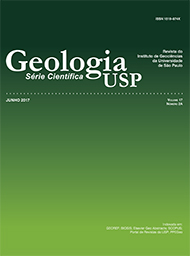Paleoenvironmental interpretation of calcretes of the Marília Formation in the Uberaba region (MG)
DOI:
https://doi.org/10.11606/issn.2316-9095.v17-423Keywords:
Continental Carbonates, Pedogenesis, Diagenesis, Late Cretaceous of Brazil.Abstract
Calcretes are continental secondary calcium carbonate accumulation that occur near topographic surface and result from pedogenic or diagenetic processes. Calcretes in the Marília Formation (Upper Cretaceous of the Bauru Basin) near the Uberaba region, Minas Gerais State, have been extensively studied from paleoclimatic and paleoenvironmental point of view. However, their origin and relationship between sedimentary, pedogenic and eodiagenetic processes have never been studied in detail. In the field, four calcrete morphologies were recognized in the Ponte Alta Member and three in the Serra da Galga Member, namely nodular, brecciated, venular, and massive, and nodular, laminar, and hardpan, respectively. The Ponte Alta calcretes are composed of ostracods, bivalves, carophytes, and extensive sparry calcite cementation and aggrading neomorphism indicating the occurrence of palustrine and phreatic processes. The Serra da Galga calcretes are formed by pedogenic and biogenic features in the nodular and laminar calcretes such as rhizoliths, <i>Microcodium</i>, and spherulites, and by superimposition of palustrine and diagenetic features in the hardpan type. The Marília Formation calcretes are associated with emergence and drop of the water table enriched in calcium carbonate into sediments and soil profiles. The predominance of palustrine and diagenetic features in the Ponte Alta Member suggests semiarid climatic conditions with periods of high precipitation or the increase in the subsidence rates during its deposition.
Downloads
Downloads
Published
Issue
Section
License
Authors who publish in this journal shall comply with the following terms:
- Authors keep their copyright and grant to Geologia USP: Série Científica the right of first publication, with the paper under the Creative Commons BY-NC-SA license (summary of the license: https://creativecommons.org/licenses/by-nc-sa/4.0 | full text of the license: https://creativecommons.org/licenses/by-nc-sa/4.0/legalcode) that allows the non-commercial sharing of the paper and granting the proper copyrights of the first publication in this journal.
- Authors are authorized to take additional contracts separately, for non-exclusive distribution of the version of the paper published in this journal (publish in institutional repository or as a book chapter), granting the proper copyrights of first publication in this journal.
- Authors are allowed and encouraged to publish and distribute their paper online (in institutional repositories or their personal page) at any point before or during the editorial process, since this can generate productive changes as well as increase the impact and citation of the published paper (See The effect of Open Access and downloads on citation impact).





